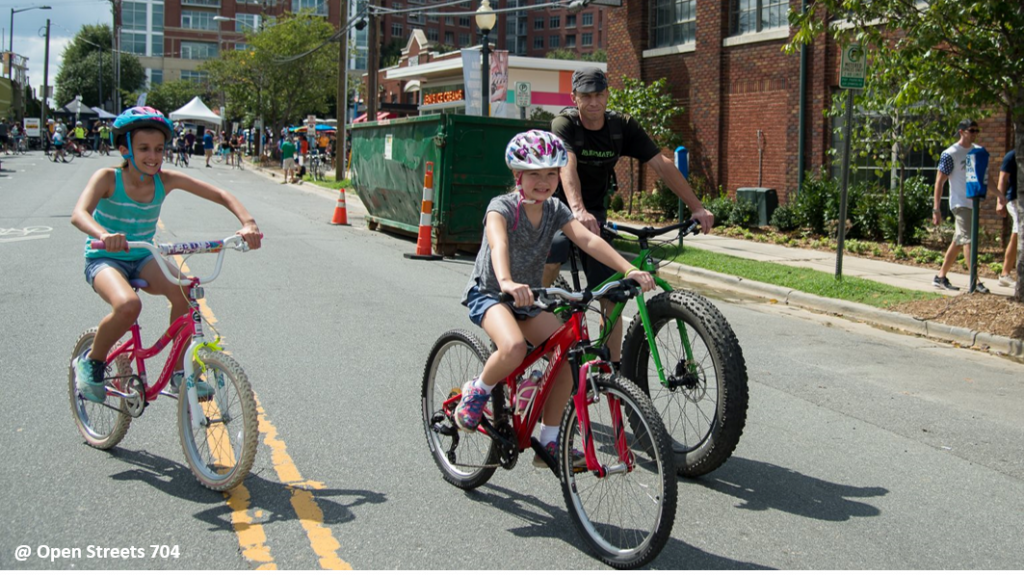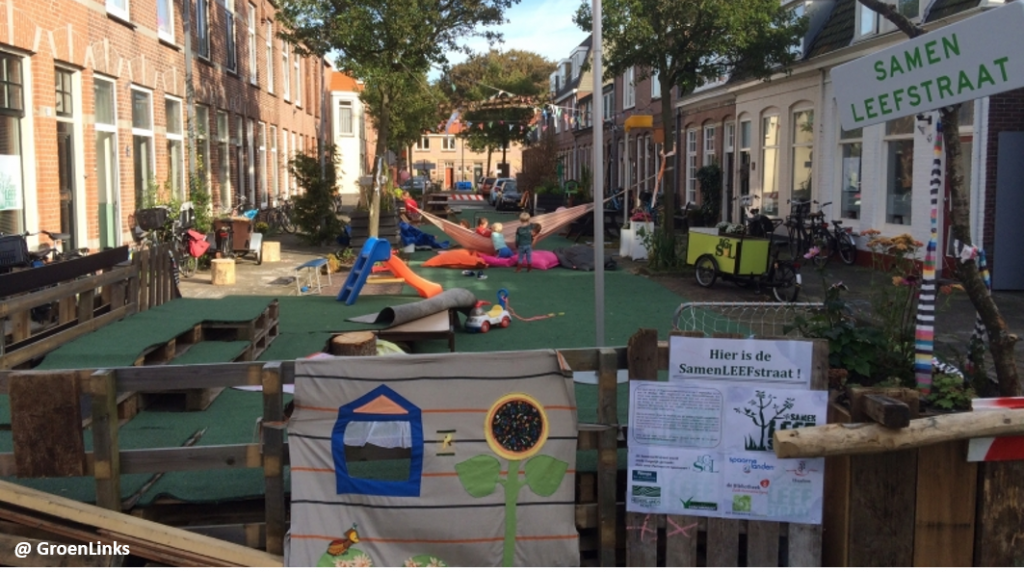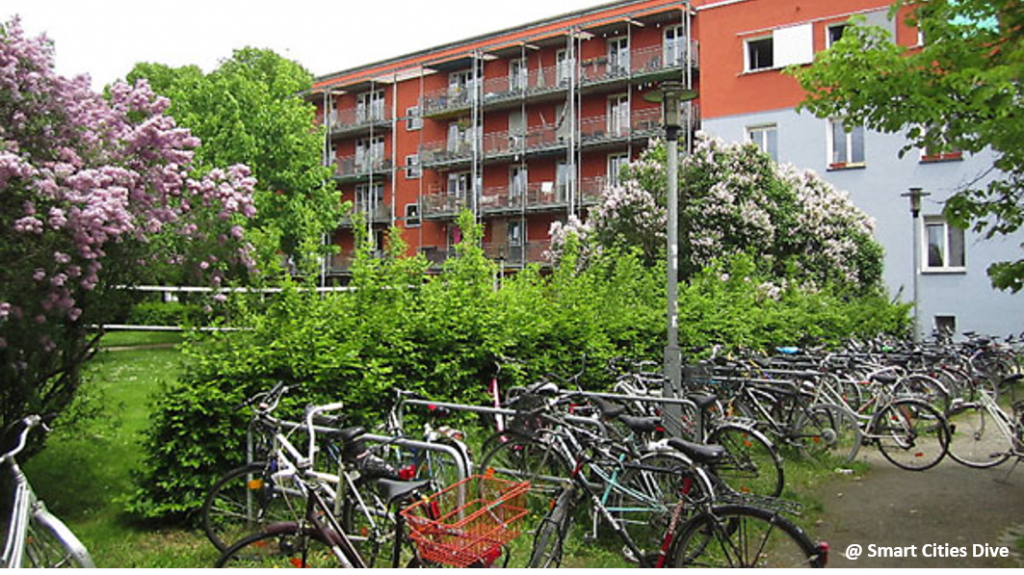
1. Presentation
Planning of specific areas exempt from cars by prohibiting access, closing roads or relocating space for cyclists and pedestrians. This measure works by itself to completely remove the car. In contrast, the Limited car access zones measure seeks to reduce traffic and, despite being the most effective, it only works if associated with other measures of the same type.
The Car free zones measure applies to cases where the active modes’ need for space is too high, making it impossible to share the space with motorized modes (as is the case of shopping streets). This measure can also be extended to larger areas.
2. Objectives
- Blocking road traffic in certain areas, contributing to the reduction of air pollution;
- Developing or converting existing road lanes into pedestrian, cycle and public transport routes;
- Revitalizing central areas, create livable streets;
- Encouraging more people to cycle.
3. Measure’s Importance
Restricting car use coupled with the creation of favourable conditions for soft mobility provide comfort and safety for the cycling, and helps to create an efficient and attractive environment for other active modes of transport. These measures contribute to make more pleasant streets and less dominated by motorized transport.
1. Good Practices
– This measure should be applied when the active modes’ need for space is too high for sharing it with motorized modes (such as shopping streets) and can be extended to larger areas depending on the city agenda.
– Design the intervention taking into account that the streets are used for various purposes, namely, traveling, walking, socializing, businesses and living since streets are the entrance spaces for dwellings.
– Facilitate pedestrian and cycling connectivity by creating passages whenever possible.
– Create comfortable pedestrian and cycle paths and intersections (See Cycling Network and Safe and efficient intersections).
– Create narrow roads and compact intersections to reduce pedestrian and bicycles crossing space.
– Maximize pedestrian and cycling accessibility (See Urban sprawl restriction and rectification, Connecting people and schools, Connecting people and public transport).
– Make sure that cycling facilities and easy access to public transport exist before discouraging the car.
– New interventions should receive extra signalling to alert new conditions. After a few years, the extra signs may be removed.
– Explain the principles behind the measures to make it clear its importance and impacts (See Information).
– Monitor and reframe measures to meet user needs without compromising sustainable ideals (See Management, Monitoring and Maintenance).
2. Actions
 | Car-free zones Zones (residential neighbourhoods or commercial streets) where the private car is unnecessary, discouraged and restricted. These restrictions are permanent, but may include exceptions for delivery vehicles, taxis and vehicles for people with disabilities. These areas require a pedestrian and cycling-specific urban design and easy access to public transport. Note: When applied to a small area it usually has modest impacts. It can move traffic to other parts of the city, unless implemented with other disincentives to driving and improvements to pedestrians, bicycles and public transport. |

The Open Streets 704 project temporarily closes streets to motorized traffic in Charlotte (USA), with a set of activities along the routes only accessible on foot or by bike. The initiative has the financial support of several companies and organizations. These temporary initiatives are a low-cost measure for testing more definitive solutions and assessing public acceptance, while showing that change is possible without infrastructure intervention.
Learn more: http://openstreets704.com/

“Light Leefstraat” (live the street) movement in Haarlem (Netherlands) was carried out quickly and at low cost thanks to the initiative of the residents. The movement also launched a motion for residents of other streets to register and organize a “living street” together.
Learn more: https://haarlem.groenlinks.nl/nieuws/motie-leefstraat-dankzij-bewonersinitiatief-supersnel-uitgevoerd (in Dutch).
1. Impacts
 | Mobility system efficiency Eliminates congestion and reduces conflicts between different means of transport. The of impact varies by implementation area, smaller areas may create congestion at the borders. |
 | Livable streets The car-free spaces are designed to prioritize pedestrians and cyclists, creating more livable streets. |
 | Protection of the environment It eliminates air and noise pollution in car-free zones and the emissions that would be created by the residents when they would travel outside these zones. |
 | Inclusion, equity and accessibility With exemptions for vehicles for people with reduced mobility and access to public transport, then inequalities created by the private car would be reduced. |
 | Safety and comfort Eliminating the car reduces accidents and promoting the use of public space creates there is more surveillance. |
 | Economic value Street businesses have more exposure due to the greater presence of cyclists and pedestrians. |
 | Awareness and acceptability The population of these areas needs to be adequately informed of the benefits and alternative mobility created by the intervention. A phased approach is suggested, starting with temporary restrictions (temporary cycling streets) and smaller (parking and car restrictions) restrictions. |
Legend:
| Very positive | Positive | Neutral | Negative | Very negative |
2. Barriers
 | Legal No barriers. |
 | Finance Infrastructure reconfiguration can be expensive. However it should be noted that there are low cost temporary solutions that allow to try the projects before implementing definitive solutions. |
 | Governance The implementation process may involve public authorities, companies, and other interest groups. |
 | Political acceptability Politicians tend to be reluctant to reduce the space dedicated to cars. |
 | Public acceptability Restrictions on car traffic can lead to protests from motorists. However, pedestrians, cyclists and public transport users tend to be supportive. |
 | Technical feasibility No barriers. |
Legend:
| No barrier | Minimum barrier | Moderate barrier | Significant barrier |
3. Budget
It requires the purchase of services to draw a mobility plan for the area and surrounding.
It is also necessary to hire a team with the necessary knowledge to redesign the public space. The costs of applying the new design vary depending on the level of difficulty and the materials used.
There are low cost temporary solutions that allow to try the project before implementing definitive solutions.
Case study 1: Car-free city centre in Oslo (Norway)
Oslo is one of the fastest growing cities in Europe, thanks to rising birth rates, life expectancy and immigration. This growth is accompanied by the vision of giving people the possibility of living in the city centre, with quality of life and without having to have a private car. It was the first city to declare the objective to completely ban the car from the city centre by 2019 through a strategy focused on pedestrians, cycling and public transportation. The film above dates from 2017, but in 2019 the municipality reached the goal of a car free city centre. The municipality’s efforts have been recognized by achieving the 7th place in the 2019 Copenhagenize ranking of the world’s most bicycle-friendly cities, and it is also an example for cities that consider to have no conditions to promote cycling due to orography or weather
Learn more: copenhagenizeindex.eu/cities/oslo
Impact:
 | Mobility system efficiency The city centre mobility system has become fully efficient through the integration of pedestrian, cycling and public transport. |
 | Livable streets The quality of life in the city centre has increased exponentially, giving the city centre new life. |
 | Protection of the environment The measure contributes to the widespread improvement of air quality in the city centre and also helps on the fight against climate change. |
 | Inclusion, equity and accessibility The measure includes financial incentives for the purchase of bicycles and cargo bikes, as well as a winter-equipped bike share system. |
 | Safety and comfort Removing cars from the city centre has created the safety and comfort conditions necessary for pedestrian and cycling. |
 | Economic value Despite initial concerns from the local businesses, removing the cars has made the city centre one of the most attractive areas of the city, with positive impacts on the local economy. |
 | Awareness and acceptability Changing habits on a car-designed city faces resistance, but the measures implemented were instrumental in raising awareness and providing the necessary conditions for car-free living. |
Case study 2: Vauban, Freiburg (Germany)

This neighbourhood, developed in former military base, was designed with an idea of reducing the ecological footprint. In addition to sustainable housing design, mobility is based on active means of transport. The neighbourhood was designed to make schools, tram stops and businesses accessible be walking. In addition, the cycling infrastructure is a well-connected and efficient network, promoting bicycle use over other transports. Although there is a community car parking on the border of the neighbourhood, in 2014 about 70% of residents lived without a car.
Impact:
 | Mobility system efficiency Planning for sustainable modes has avoided conflicts between different methods, allowing for high efficiency of the alternative modes of transport. |
 | Livable streets By promoting pedestrian and cycling access, the streets have become more attractive and livable. |
 | Protection of the environment The construction of both houses and transport sustainable infrastructure has reduced the neighbourhood’s ecological footprint. |
 | Inclusion, equity and accessibility No data. |
 | Safety and comfort Removing the cars eliminates the probability of serious accidents. In addition, by creating the conditions for space to be used by pedestrian and bicycles, there is more street surveillance. |
 | Economic value No data. |
 | Awareness and acceptability Since the neighbourhood was created almost from scratch, most of the people chose to live here, revealing a predisposition to more sustainable living habits. |
Legend:
| Very positive | Positive | Neutral | Negative | Very negative |
KonSULT. Knowledgebase on Sustainable Urban Land use and Transport. (2014). Physical Restrictions. Accessed 18 June 2019. Available at: http://www.konsult.leeds.ac.uk/pg/12/#a
Thorpe, D. (2014) The World’s Most Successful Model for Sustainable Urban Development? Smart Cities Dive. Accessed 18 June 2019. Available at: https://www.smartcitiesdive.com/ex/sustainablecitiescollective/words-most-successful-model-sustainable-urban-development/229316/
VTPI. Victoria Transport Policy Institute (2018). Car-Free Planning. Online Transportation Demand Management (TDM) Encyclopedia. Accessed 18 June 2019. Available at: https://www.vtpi.org/tdm/tdm6.htm
